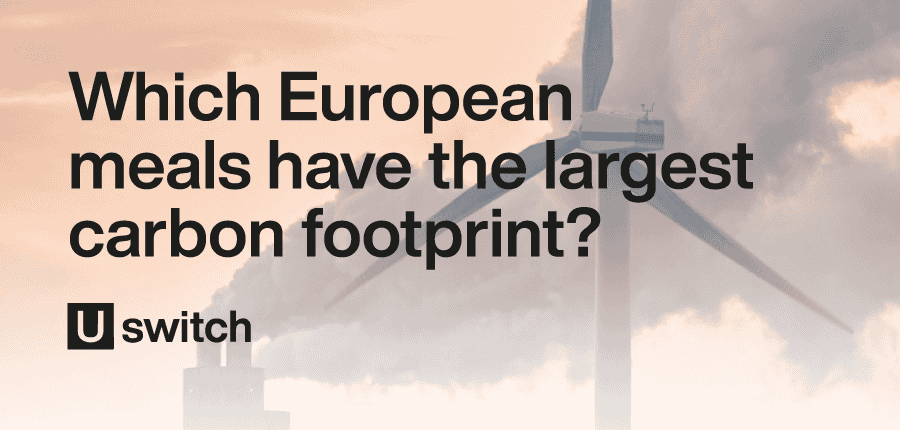
One of the biggest causes of climate change is our daily meals, with food accounts for a quarter of global emissions. Since food airline miles are a major contributor to your carbon footprint, the comparison of green energy Uswitch experts were interested in finding out which popular European meals produce the largest carbon footprint.
To do this, we compiled a list of popular dishes before using multiple sources to find the gCO2e emissions (CO2 emissions with the same global warming potential as other greenhouse gases) for each ingredient per serving of the meal.

Bad news for beef stew lovers. Stoofvlees, otherwise known as Flemish beef stew, has the largest carbon footprint of Europe’s most popular dishes, with a total of 11,202 gCO2e per serving. This warming meal also requires one kilogram of beef which creates 10,832 gCO2e.
A hearty dish, known in Germany as goulash, it is often prepared to feed the family on a cold night. However, the stewed steak required for this recipe means that around 8,055 gCO2e are released for each serving. These are the same emissions released when driving just over 19 miles or 32km.
By using potatoes instead of aubergines, Bulgarian moussaka can produce 6,491 gCO2e per serving, which ranks it third among European meals with the largest carbon footprint. The largest contributor to this carbon footprint is the kilogram of beef needed in the recipe, which alone produces 5,416 gCO2e.
Cooking frenchinha (a Portuguese sandwich) and kotletes (Latvian meatballs) yields 6,260 and 3,877 gCO2e per serving, respectively. The Portuguese sandwich has such a large carbon footprint as it includes several different types of meat, including pork and beef trimmings, while the meatballs focus on ground beef.
The traditional makaronilaatikko (a baked macaroni casserole) and Greek moussaka both produce emissions of over 2,000 gCO2e. The Finnish dish is slightly over 2,552 gCO2e thanks to the tasty blend of lamb meat, cottage cheese and chopped tomatoes.
The popular Irish dish of coddle commonly consists of layers of sausages, potatoes, bacon slices, onion, and roughly sliced carrots in a rich chicken stock. For each serving of this meal, 1,488 gCO2e is released, as if you were driving 3.6 miles. However, if you cook this meal in the traditional sense using leftovers, the carbon footprint of this dish can be drastically reduced.
The bottom two European dishes with the greatest potential for climate impact are Spanish rice and seafood fideua and Austrian kaiserschmarrn (butter pancakes). While these are very different in terms of ingredients and flavour, they are quite similar in terms of carbon footprints, with 1,320 and 1,159 gCO2e each.
Many see Christmas as a time for indulgence, especially when it comes to meals. But which type of European Christmas food produces the largest carbon footprint?
With meat accounting for more than 60 percent of all greenhouse gases from food production, it’s no surprise that most of the best-for-carbon foods fall into this category. Indeed, the top 13 include some animal product elements, with the largest carbon footprint coming from the consumption of venison (1,784 gCO2e). This is followed by roast pork and ham, with 749 gCO2e each.
A single serving of Latvian Gray Peas and Bacon is prepared using 120g of peas and 30g of bacon as a base, which has the potential to emit 706g of CO2e. This is the fourth-highest carbon footprint of all popular Christmas foods studied, and is equivalent to driving nearly two miles (2.8 km).
Another popular high-emission Christmas food is pork-based offerings, including sausages with sauerkraut, pork alone, and sausages alone with 692, 663, and 563 gCO2e, respectively. If you choose to have all these pork products over Christmas, the emissions released would be the same as driving 4.6 miles or 7.5km.
To keep tabs on your holiday, you can calculate your carbon footprint and see the environmental effect you’re currently having without the extra extravagance of Christmas.
Reduce that footprint by following these tips from energy expert, Will Owen, per low energy cooking:
“1. Use a microwave more than an oven
When it comes to reheating and cooking food, the microwave is the most efficient method: it’s always faster, and its smaller size (compared to the oven) allows for more even heat distribution. Hence, it is a good choice to use the microwave whenever possible.
2. Defrost food whenever possible
The refrigerator can be used to defrost food that has been frozen overnight or while you are working. Thawing ahead of time not only cuts prep time, but also eliminates the need to use a microwave for faster defrosting.
The hardest part is remembering to remove food from the freezer long before you need it.
3. Cook in glass or ceramic dishes
When cooking, try to use glass or ceramic dishes whenever possible. These are the best materials to use in the oven because they retain heat better than their metal counterparts.
Thanks to the increased efficiency of these dishes, you can even lower the heat than necessary or reduce the overall cooking time.
4. Choose a smaller pan
If you use a pan of the right size for the amount of food you’re cooking, you’ll use less energy than you would if you heated a larger surface area than necessary.
You should also try to use the right stovetop size for your pan when you selected it. The bigger the burner, the longer it will take to reach the right temperature and a pan that is too big will waste energy”.
Find how reduce your carbon footprint.
#European #meals #largest #carbon #footprint

Comments
Post a Comment